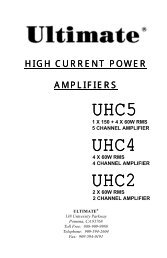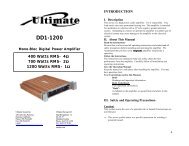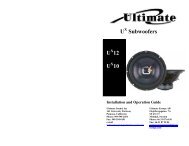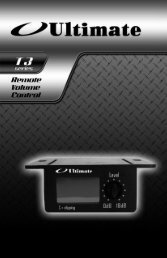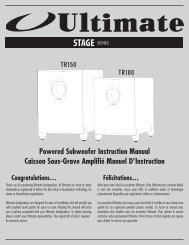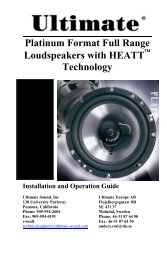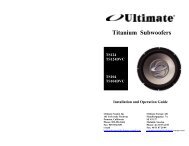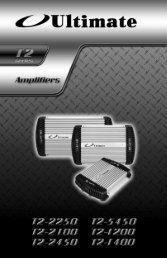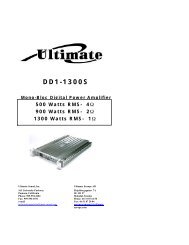You also want an ePaper? Increase the reach of your titles
YUMPU automatically turns print PDFs into web optimized ePapers that Google loves.
INTRODUCTIONMOBILE POWER AMPLIFIERSTA46004 X 250 WATT4 CHANNEL AMPLIFIERTA43204 X 140 WATT4 CHANNEL AMPLIFIERTA27002 X 600 WATT2 CHANNEL AMPLIFIERTA23002 X 250 WATT2 CHANNEL AMPLIFIERTA21602 X 165 WATT2 CHANNEL AMPLIFIER<strong>Ultimate</strong> <strong>Sound</strong>, Inc.138 University ParkwayPomona, CA 91768Toll Free: 888-909-9988Telephone: 909-594-2604Fax: 909-594-0191I. DescriptionThis device is a high power, audio amplifier. Use it responsibly. Veryloud music can cause permanent hearing loss. This amplifier is intendedfor installation in vehicles with a 12-Volt, negative ground electricalsystem. Attempting to connect or operate the amplifier in another type ofelectrical system may cause damage to the amplifier or the electricalsystem.II. About This ManualRead the Instructions-Be sure that you have read all operating instructions and understand allsafety precautions before installing and operating the amplifier. Werecommend that you have your TA series amplifier installed by aspecialist.Follow the Instructions-The instructions are intended to help you safely obtain the bestperformance from the amplifier. Carefully follow all installation andoperating instructions.Save the Operating Manual-Keep the manual in a safe place after installing the amplifier. You mayhave questions later.Text Conventions used in this Manual-Bold-Headings and important information.Bold, Underlined-Very important information."Bold"-As labeled on the amplifier, or quoted from elsewhere in thismanual.III. Safety and Operating Precautions-Caution!This symbol warns the user of a potential risk or hazard if instructions arenot followed.⇒ This arrow symbol points to a specific instruction for avoiding apotential hazard.ii
1. Installation1.1 Installation- Mounting the AmplifierStep 1- Disconnect the negative (-) battery cable before mounting theamplifier or making any connections. Check the battery and alternatorground (-) connections. Make sure they are properly connected and free ofcorrosionStep 2- Choose a mounting location for your amplifier. Find a locationon a flat surface away from heat and moisture. Be sure the mountinglocation and the drilling of pilot holes for mounting will not present ahazard to any wires, control cables, fuel lines, fuel tanks, hydraulic lines,or other vehicle systems or components. Common mounting locations areunder the front passenger seat, or in the trunk area. Choose a locationwith unimpaired air circulation. The amplifier will dissipate heat moreefficiently if mounted vertically.Step 3- Use the supplied screws. Place the amplifier in the mountinglocation, and mark the positions of the holes with a marker, pen or pencil.Carefully drill the mounting holes in the marked positions.Caution!⇒ Check carefully before drilling any pilot holes.Step 4- Use the supplied mounting screws to securely fasten the amplifierto the mounting surface.1.2 Installation- Power ConnectionsStep 1- Run a power cable from the battery to the amplifier mountinglocation. Use rubber grommets to protect the cable anywhere it has to gothrough metal.TA4600, TA4320, TA2700, TA2300 - Use #8 AWG or larger powerand ground cable.TA2160 - Use #10 AWG or larger power and ground cable.Step 2- Connect one end of an in-line fuse holder to the power cable.Connect the other end of the fuse holder to the positive battery post with20 cm (or less) of the same cable. This fuse location will protect thesystem and the vehicle against the possibility of a short circuit in thepower cable. Be sure to use a fuse and fuse holder adequate for theapplication. Do not place a fuse in the holder at this time.Caution!⇒ Bridging fuses or replacing a fuse with one of a higher rating maycause damage to the amplifier and the vehicle's electrical system.Step 3- Run a remote turn on cable from the switched +12V source youwill be using to turn on the system components. This may be a toggleswitch, a relay, or your source unit’s remote trigger wire, or powerantenna trigger wire. Run this lead to the amplifier mounting location.Use #18 AWG wire or larger.POWER+12V RMT GNDStep 4- Locate a secure grounding connection asclose to the amplifier as possible. Make sure thelocation is clean and provides a direct electricalconnection to the frame of the vehicle. Connectone end of a short piece of the same size cable asthe power cable to the grounding point. Run the other end of the cable tothe amplifier mounting location.Step 5- connect the ground cable to the screw terminal labeled“POWER, GND”.Step 6- Connect the power cable to the amplifier at the screw terminallabeled “POWER, +12V”.Step 7- Connect the remote turn on cable to the screw terminal labeled“POWER, RMT”.1.3 Installation- Speaker ConnectionsStep 1- Run #16 AWG or larger connecting wire from your speakers tothe amplifier mounting location. Keep speaker wires away from powercables and amplifier input cables. Use grommets anywhere the wires haveto pass through holes in the metal frame or sheet metal. Connect to thespeakers according to the type of terminals on each speaker.Step 2- Strip 3/8" of insulation from the end of each wire and twist thewire strands together tightly. Make sure there are no stray strands thatmight touch other wires or terminals and cause a short circuit.Step 3- Crimp spade lugs over the wire ends or tin the ends with solder toprovide a secure termination.Step 4- Connect the wire ends to your amplifier as follows:The maximum fuse rating for each amplifier in the TA series is:TA4600 - 2 X 30 Amp TA4320 - 40 AmpTA2700 - 2 X 30 Amp TA2300 - 30 AmpTA2160 - 20 Amp12
SPEAKER TERMINALSFollow the (A/B/C/D+) (A/B/C/D-), channel and polarity markings,making sure they match the channel and polarity of the connections atthe speakers.SPEAKER(A+) (A-) (B+) (B-)( + ) ( - )MULTIPLE SPEAKER CONNECTIONPARALLEL- Each additional speaker decreases the load impedancefor the amplifier. The amplifier delivers more current and worksharder.AMOPULTIPFUITERBRIDGE+-PARALLEL CONNECTION USING 4 OHM SPEAKERS4 Ohm 2 Ohm(+)(-)SPEAKER(C+) (C-) (D+) (D-)( + ) ( - )(+)(-)BRIDGESERIES- Each additional speaker increases the load impedance forthe amplifier. Impedances higher than 8 ohms are rarely used for caraudio.AMOPULTIPFUITER+-1.4 Installation- Self-Bridging, 2+1 ModeBRIDGED MONO-Connect a 4Ω ohm speaker to theterminals marked “(+), BRIDGE, (-)”,making sure they match the polarityof the connections at the speakers.Caution!⇒ Speaker or multiple speaker loadstotaling less than 4 ohms are notrecommended for “Bridged” orSERIES CONNECTION USING 4 OHM SPEAKERS4 Ohm 8 Ohm(+)(-)SPEAKER(A+) (A-) (B+) (B-)( + ) ( - )BRIDGE“2+1 Mode”, and may damage the amplifier.TA4600, TA4320-Set the “MODE” switch to “2CH, 3CH”, or “4CH” and connect thespeakers accordingly. For “3CH” operation, bridge the “C” and “D”channels.2+1 MODE- (TRI-MODE)Simultaneous stereo and mono operation, “2+1 Mode”, requires a passivecrossover to send low frequencies to the mono speaker and higherfrequencies to the stereo speakers. The following table lists thecomponent values for a 6 dB/Octave crossover at common frequenciesusing 4 ohm speakers for stereo and an 8Ω speaker for mono(subwoofer):FREQUENCY INDUCTOR CAPACITOR80 Hz 16 mH 470 uF100 Hz 7.5 mH 330 uF120 Hz 7.5mH 330 uF150 Hz 7.5 mH 220 uF(+)(-)34
2+1 MODE WIRING DIAGRAM-Use 100 Volt, non-polar capacitors, and connect them in series with thestereo speakers as shown in the diagram. Connect the inductor in serieswith the mono speaker as shown in the diagram. Be sure the inductor israted to handle the power of your amplifier.(A+)(A-)(B+)(B-)1.5 Installation- InputConnectionsLow Level, High Impedance, Gold Plated RCAInput Jacks-For connecting to a source providing preamp leveloutputs. Use heavy duty RCA patch cords designed formobile applications . Run the patch cables carefully,maintaining as much distance as possible from power,speaker, and accessory wiring. Make sure the RCAplugs fit tightly for a secure connection.Speaker Level Input Connector-HIGH LEVELINDUCTOR(+)Use the supplied wiring harness to connect the speakeroutputs from the source unit(AM/FM/CD/DVD or Cassette)to the “HIGH LEVEL” input.Wiring Harness Color Code- 2 ChannelWhite Wire A Channel Positive( + )White/Black Wire A Channel Negative( - )Gray Wire B Channel Positive( + )Gray/Black Wire B Channel Negative( - )Black WireGroundNo Other Connection(-)(+)(-)CAPACITORS(+)(-)ABINPUTHIGH LEVELWiring Harness Color Code- 4 ChannelWhite Wire Channel A Positive( + )White/Black Wire Channel A Negative( - )Gray Wire Channel B Positive( + )Gray/Black Wire Channel B Negative( - )Green Wire Channel C Positive( + )Green/Black Wire Channel C Negative( - )Violet Wire Channel D Positive( + )Violet/Black Wire Channel D Negative( - )Black WireGroundNo Other Connection1.6 Installation- Check all ConnectionsRecheck all connections before reconnecting the negative(-) battery cable.Insert the correct value fuse in the fuse holder at the battery beforeattempting to turn on the system.2. Operation2.1 Operation- Input Level adjustmentsLEVELMIN MAXAdjust the input level for the marked channel(s) with a smallscrewdriver through the opening marked “LEVEL”. TurnCW(clockwise) to increase the level, CCW(counterclockwise)to decrease. Amplifiers will run cooler and produce lesssystem noise at lower level settings.Consult an experienced installation specialist for assistance in balancingthe levels in multi-amplifier systems, or systems with signal processingaccessories.56
2.2 Operation- Built-in CrossoversCROSSOVER FILTER SELECTIONThe TA series amplifiers have built-in low-pass andX-OVERhigh-pass crossover filters for bi-amplifying yoursystem. Select " LPF, FULL or HPF" by movingLPF- FULL- HPFthe position of the slide switch for each pair ofchannels. "LPF" selects the low pass filter. "HPF"selects the high pass filter. Selecting "FULL" defeats the crossoverfunctionsFREQUENCY ADJUSTMENTLPF40-240After selecting the crossover function, adjust the low pass orhigh pass frequency control with a small screwdriver throughthe opening marked “LP/FREQ.” or "HP/FREQ.". TurnCW to set to a higher frequency, CCW to set to a lowerfrequency.OVERLOAD AND SHORT CIRCUIT PROTECTION- The amplifierwill shut down if a short circuit condition exists, or if electrical currentdemands exceed safe levels.FUSE15A15AFUSE PROTECTION- A blown fuse indicates a problem thatshould be corrected before the fuse is replaced. Always replacewith the same value fuse. Never substitute a larger value fuse.2.4 Operation- Location of Terminals,Controls and LED indicatorsTA4600, TA43201. RCA input jacks 2. High level input 3. Input level adjust4. Crossover select 5. Low pass freq. 6. High pass freq.7. Bass boost 8. Mode 9. Power L.E.D.10. Protection L.E.D.BASS-BOOSTONOFFPOWERPROTECTTurning the “BASS BOOST” switch to “ON” increases the levelof frequencies around 45Hz by 12dB.2.3 Operation- Protection Circuits andL.E.D. Indicators“POWER.” L.E.D. INDICATOR- Provides a visual indicationthat the amplifier is turned on.“PROTECT” L.E.D. INDICATOR- Provides a visualindication that a problem exists and the protection circuitry hasprotected the amplifier by shutting it down. Turn the systemoff and correct the problem before turning the system on.THERMAL PROTECTION- The amplifier will shut down if itstemperature exceeds a safe operating level. The amplifier will remain offuntil it cools to a safe operating temperature. Exercise care, the exterior ofthe amplifier may get uncomfortably hot to the touch before shuttingdown.9 1 3 6 5 2 5 6 3 1 10A/B CHANNELSC/D CHANNELHIGH LEVELINPUT LEVEL HPF LPFLPF HPF LEVELINPUTACPOWERMIN MAX 40 240 40 24040 240 40 240 MIN MAXPROTECTBX-OVER BASS-BOOST MODEDBASS-BOOST X-OVERLPF HPF ON OFF 2CH 3CH 4CH ON OFF LPF HPFFULL FULL4 7 8 7 42 1 3 3FUSEPOWER SPEAKER SPEAKER+12V RMT GND ( A+ ) ( A- ) ( B- ) ( B+ ) ( C+ ) ( C- ) ( D- ) ( D+ )30A 30A( + ) ( - )( + ) ( - )BRIDGEDBRIDGED1. Power terminals 2. Fuse(s) 3. Speaker terminals78
TA2700, TA2300, TA21601. RCA input jacks 2. High level input 3. Input level adjust4. Bass Boost 5. Low pass freq. 6. Crossover select7. High pass freq. 8. Power L.E.D. 9. Protection L.E.D.8 2 1 3 4 5 6 7 9POWERHIGH LEVELLR1. Power terminals 2. Fuse(s) 3. Speaker terminals2FUSE15AINPUT LEVEL BASS-BOOSTMIN+12VMAXON1POWERRMTOFFGNDLPF X-OVER HPF40 240LPFFULLHPF40 240SPEAKER( A+ ) ( A- ) ( B- ) ( B+ )( + ) ( - )BRIDGED3PROTECTFeatures and Specifications:2Ω StableBridgeableTri-modeTerminalsSoft StartInputsCrossoverBass BoostProtectionPowerSupplyRMS/MaxPower, 4Ω,THD
Troubleshooting:Condition Possible Cause Possible SolutionNo soundAmplifiershut downDistortionPoor bassresponseTickingnoiseWhiningnoiseLow or no remote turnon voltage, or no remoteturn on connectionBlown fuse(s)Wiring problemsBlown speakersProtection circuitprotecting againstoverheating or overloadInput level not properlyadjustedSpeaker damageSpeakers out of phaseRadiated noise fromspark plug wiresAlternator noise causedby poor grounding ofamplifier, source, othercomponent, battery, oralternatorCheck the remote turn onconnection and the voltage atthe amplifier and source unitCheck all system fusesRecheck all connectionsCheck for short circuitsCheck speakers on anotheramplifierCheck for adequate ventilationCheck load impedance(2 ohmstereo, 4 ohm bridged)Check speaker wiring for shortto the vehicle chassisReduce input levelReadjust amplifier input levelCheck speakers on anotheramplifierRecheck speaker wiringReverse polarity of one channelReroute amplifier input wiringInstall a noise filterCheck all ground connectionsInstall a noise filter on thesource unit’s power cableInstall a coupling transformerin the signal path to improveground isolation for the signalpath11



